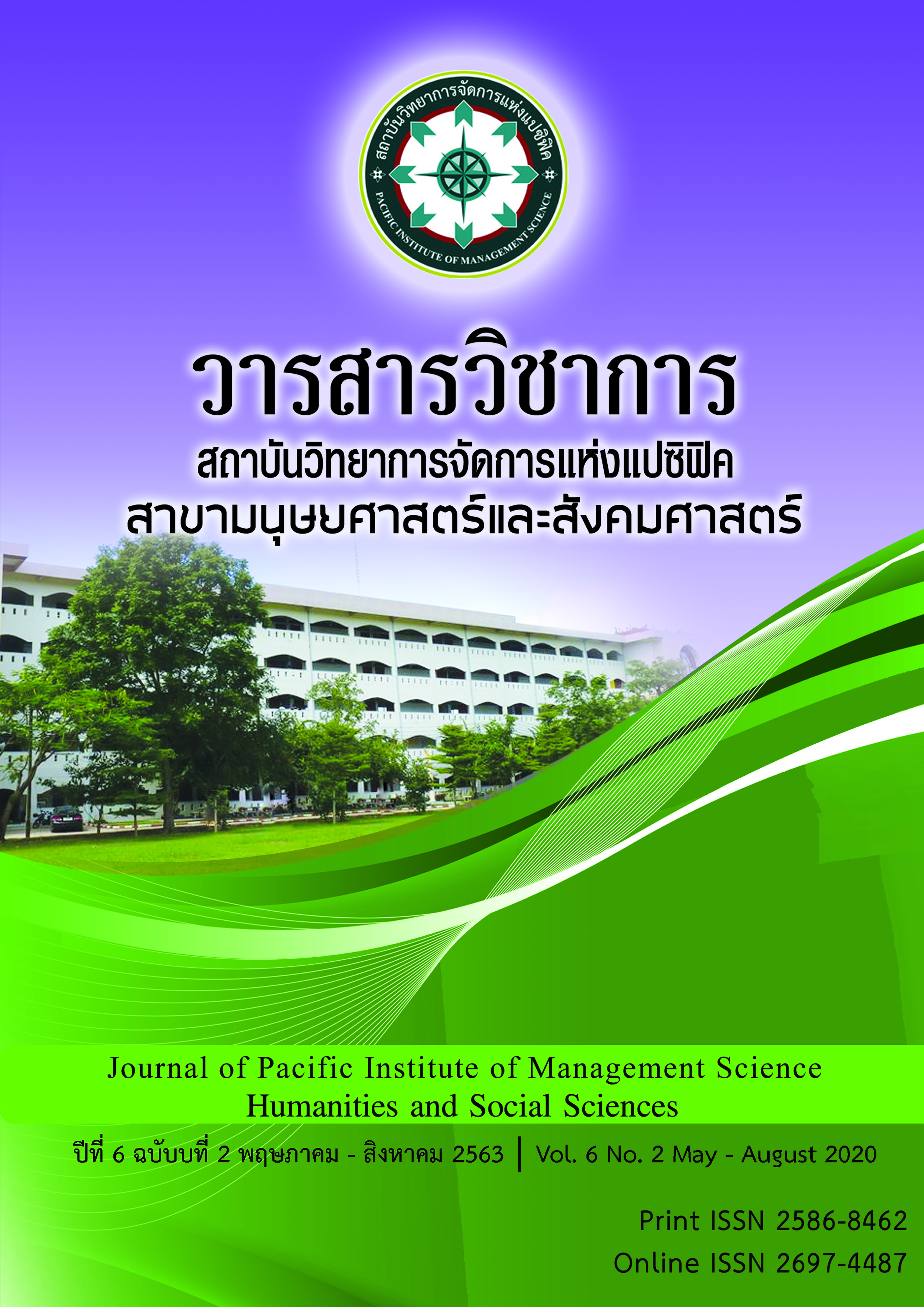PEOPLE’S PARTICIPATION IN THE PRESERVATION OFTHAI ARCHITECTURE IN RATANAKOSIN ISLANDs AREA
Keywords:
People’s Participation, Preservation Thai ArchitectureAbstract
The objectives of this study were twofold : (1) to investigate the people’s participation in the preservation of Thai architecture in the Ratanakosin Island area, and (2) to determine the problems and obstacles relating to the people’s participation in preserving Thai architecture in the Ratanakosin Island area. The study was qualitative in character. The sample consisted of 17 key informants; the key informants included people of high caliber. That was to say, they were topflight policy makers, high-ranking officers, and experts; and they all had deep knowledge and understanding as well as a lot of experience with the preservation of Thai architecture. The in-depth interviews were conducted with these key informants. The collected data were analyzed by dint of content analysis. The data analysis has brought to light the following facts :
1) On people’s participation in the preservation of Thai architecture in the Ratanakosin Island area, it can be summarized as follows : (1) The number of people taking part in the preservation of Thai architecture in the Ratanakosin Island area was on the increase as compared with their participation in the past. It was so in large measure because they had better knowledge and understanding of the great value of Thai architecture. Furthermore, the Thai Constitution has an act that grants rights to Thai citizens and community members with respect to the management and surveillance of architectural objects or artifacts. This also enabled the people to take part in the preservation of Thai architecture to a much greater extent. (2) As regards the promotion and support from the governmental agencies as far as the preservation of Thai architecture was concerned, in a nutshell, the following points could be made. Various governmental agencies provided support in various ways. For instance, they allocated budgets for use in the preservation of Thai architecture, and they provided personnel or experts with a view to helping the people learn how to preserve Thai architecture and how to organize activities relative to the Thai architecture preservation. More importantly, the governmental agencies concerned made great efforts to urge people to participate in surveillance and protection of Thai cultural and architectural heritages. (3) The private sector’s participation and support concerning the preservation of Thai architecture, the private sector played an important part in the preservation of Thai architecture. This clearly indicated that the people in the private sector had social responsibilities to a certain degree. Realizing the important role played by business organizations, the Government adopted some incentive policy in such a way that the income tax reduction for business people was enforced. In other words, business people who made financial contribution to the preservation of Thai architecture were permitted to have income tax reduction. (4) With respect to the knowledge and understanding of people as to the preservation of Thai architecture, governmental agencies concerned made attempts to keep people constantly well-informed about the preservation of Thai architecture. Armed with deep knowledge and understanding of the Thai architecture preservation, the people came to realize the value of the preservation. Consequently, they were strongly committed to protect the architectural heritage for the benefit of posterity.
2) On problems and obstacles pertaining to the people’s participation in the preservation of Thai architecture, the following facts have been discovered. (1) Some groups of people failed to appreciate the Thai architecture preservation (2) Comparatively speaking, people participation in the preservation were far from adequate. (3) The budgets from the Government were limited (4) The destruction of the Thai architecture by human beings and nature is now present. (5) Governmental agency authorities were somewhat negligent in paying attention to the people’s opinions or ideas about the Thai architecture preservation. And (6) The Government’s human resources responsible for the preservation of Thai architecture were inadequate.
References
พลอยภัทรา ตระกูลทองเจริญ. (2557). การศึกษาความตระหนักในการอนุรักษ์มรดกทางวัฒนธรรมผ่านกระบวนการการมีส่วนร่วม กรณีศึกษา: หมู่บ้านศาลาแดงเหนือ เชียงรากน้อย. มหาวิทยาลัยกรุงเทพ : กรุงเทพฯ.
ถวิลวดีบุรีกุล (2548). การมีส่วนร่วม แนวคิด ทฤษฎีและกระบวนการ, กรุงเทพฯ: สถาบันพระปกเกล้า.
ลลิดา บุญมี. (2555). แนวทางการปรับปรุงสถาปัตยกรรมสมัยใหม่ กลุ่มอาคารราชดำเนิน : กรณีศึกษา อาคารนิทรรศน์รัตนโกสินทร์. จุฬาลงกรณ์มหาวิทยาลัย/กรุงเทพฯ.
วิโรจน์ สารรัตนะ. (2544). โรงเรียนองค์การแห่งการเรียนรู้กรอบแนวคิดเชิงทฤษฎีทางการบริหารการศึกษา. กรุงเทพฯ : ห้างหุ้นส่วนจำกัด ทิพย์วิสุทธิ.
ฐานิศวร์ เจริญพงศ์ และปิ่นรัชฎ์ กาญจนัษฐิติ. (2554). การอนุรักษ์มรดกสถาปัตยกรรมและชุมชน. กรุงเทพ : โรงพิมพ์แห่งจุฬาลงกรณ์มหาวิทยาลัย.
ธราธร สุวรรณรักษ์ (2552) โครงการพัฒนาตลาดวัฒนธรรมในพื้นที่เกาะรัตนโกสินทร์: กรณีศึกษาชุมชนท่าเตียนโครงการพัฒนาตลาดวัฒนธรรมในพื้นที่เกาะรัตนโกสินทร์: กรณีศึกษาชุมชน ท่าเตียน. วิทยาลัยนวัตกรรม มหาวิทยาลัยธรรมศาสตร์.
อธิวัฒน์ สีดา. (2552). แรงจูงใจในการอนุรักษ์อาคารประวัติศาสตร์ :กรณีศึกษาอาคารตึกแถวในกรุงรัตนโกสินทร์. มหาวิทยาลัยธรรมศาสตร์ : กรุงเทพฯ.
Pimonsathean, Y.(1999). Thailand. Built Environment.Conservation Education as a Form of Community Service in Bangkok.
Thaitakoo, Pimonsathean. (1999). Banks, and James A. 2001. Cultural Diversity and Education : Foundations, Curriculum, and Teaching. Boston: Allyn and Bacon.
Kammeier, H.D. (2004). Sustainable City Symposium of Bangkok. หจก.เชียงใหม่โรงพิมพ์แสงศิลป์.
United Nation. (1998). Popular Participation In Decision Making For Development, New York: United Notwess Publication.
Downloads
Published
Issue
Section
License
บทความที่ได้รับการตีพิมพ์เป็นลิขสิทธิ์ของ สถาบันวิทยาการจัดการแห่งแปซิฟิค
ข้อความที่ปรากฏในบทความแต่ละเรื่องในวารสารวิชาการเล่มนี้เป็นความคิดเห็นส่วนตัวของผู้เขียนแต่ละท่านไม่เกี่ยวข้องกับสถาบันวิทยาการจัดการแห่งแปซิฟิค และคณาจารย์ท่านอื่นๆในสถาบันฯ แต่อย่างใด ความรับผิดชอบองค์ประกอบทั้งหมดของบทความแต่ละเรื่องเป็นของผู้เขียนแต่ละท่าน หากมีความผิดพลาดใดๆ ผู้เขียนแต่ละท่านจะรับผิดชอบบทความของตนเองแต่ผู้เดียว







